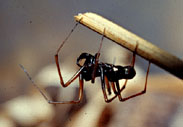The Amazing Spiderman
If there's one laboratory on campus that requires no decorating at Halloween, it must be that of Chris Buddle, McGill's very own Spiderman. Buddle does not climb walls or swing from webs, but he has devoted his academic career to studying the organisms that do. After arriving at Macdonald campus last year as an assistant professor of forest insect ecology, Buddle initiated a variety of research programs, including long-term biodiversity monitoring at McGill's field stations. Looking at spiders and insects as an indicator of ecosystem health, Buddle will use his database to investigate large-scale environmental concerns.

Chris Buddle
The diversity of life on Earth, estimated at around 13 billion species, is rapidly being eroded. The United Nations Environment Programme estimates that 34,000 plant and 5,200 animal species currently face extinction. Environmental concerns such as habitat destruction, global warming and pollution are to blame -- the consequence of our attempt to cram 6 billion people onto one small planet.
A diverse ecosystem is a healthy ecosystem, one that is better able to provide the fundamental natural services we take for granted, such as climate control, air and water purification, and nutrient cycling. Every organism, from the massive to the microscopic, is an essential ecosystem component -- even the creepy crawlies that many love to hate. Arthropods, including spiders and insects, comprise much of the world's biodiversity and are of great importance in understanding how we affect our natural environment.
Buddle has initiated a monitoring project capable of addressing large-scale environmental concerns. The variability of nature means that only a long-term database can track the link between environmental change and biodiversity. It is too early to start making predictions on this project that will be the envy of many scientists.
"Biodiversity monitoring requires researchers to be able to access the same field sites year after year," said Buddle. "Being hired at McGill offered me both the stability to initiate such a research program and a wealth of locations within which to work." Baseline data is currently being collected at the Gault Nature Reserve at Mont St. Hilaire, and will soon be expanded to the university's other field sites.
Creeping around Quebec's forests looking for bugs may sound like wearisome work, but Buddle has a method that takes the pain out of painstaking: "I locate my invertebrate friends where their diversity is high -- in dead wood," explained Buddle. Dead wood plays an essential role in forest nutrient cycling. "It decomposes, becoming part of the forest floor," said Buddle. It is not as dead as you might think; the wood is also an extremely important microhabitat for arthropods, and the reasons for this are not fully clear.
In terms of structure, dead wood contains the perfect habitat for many spider species. Networks of cracks and crevices provide spiders with an abundance of web-spinning options. "Dead wood is also home for numerous other critters, which are present to assist in the decomposition process," explained Buddle. "These organisms are exactly the right food source for spiders." Food and shelter may be the two main requirements for a comfortable spider life, but according to Buddle there are many other, poorly understood factors that may influence the diversity of these organisms. "We're finding species that we know little about," said Buddle. "If we can understand the reasons why they like this habitat, then we have a better ability to understand their distribution."
Buddle never seems to stop working: spiders collected while relaxing around the home or on family outings are stored in the Buddle family freezer, a veritable museum of eight-legged bodies inside small plastic film canisters. "I tend to receive one of two reactions to my research," explained Buddle. "'Oh wow,' or 'oh yuck.'" Every web has its silver lining, however; according to Buddle, even those who turn green at the thought of a spider are still fascinated by the research. "It tends to be fascination via revulsion, though," joked Buddle. It's a good job spiderwoman does not have the phobia this species commonly elicits in others. "My wife does find it odd, but it's something that she's grown to accept," he explained. "As I say to her, spiders have been very good to us!"
